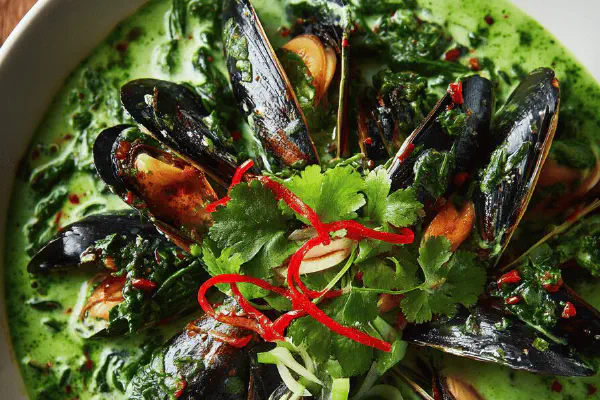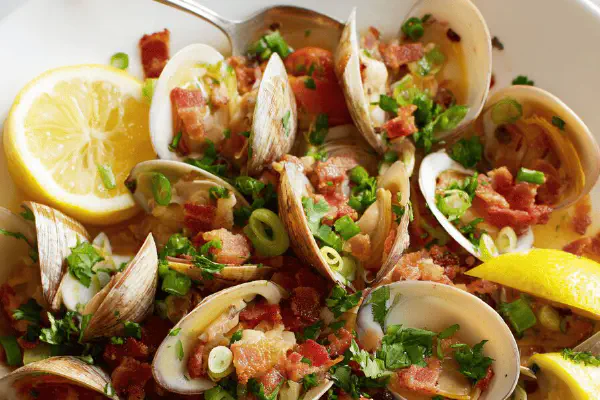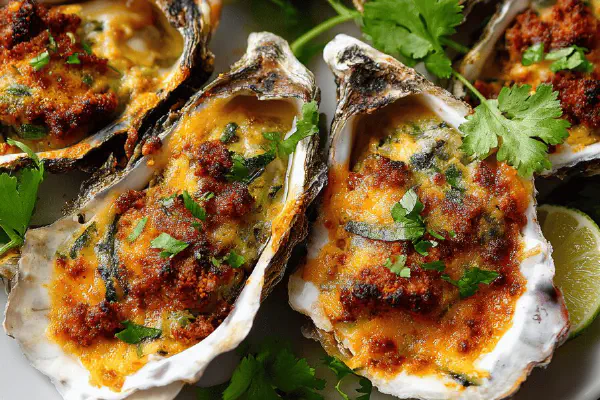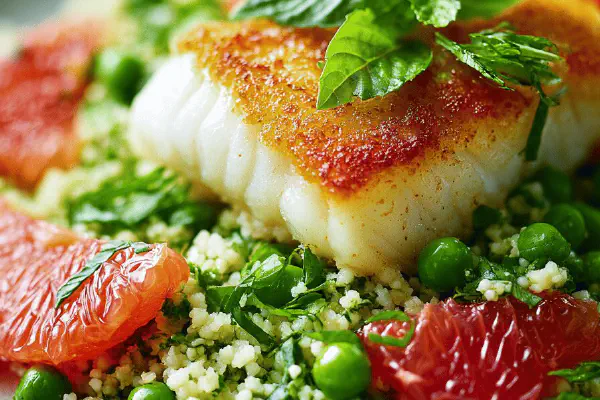Green Salsa Mussels

By Emma
Certified Culinary Professional
Ingredients
- 150 ml white dry wine
- 1 large clove garlic, minced finely
- 90 ml flat-leaf parsley tightly packed
- 8 fresh basil leaves
- 400 ml fresh kale leaves, thick stems removed
- Few dashes hot sauce of choice
- Salt and freshly crushed black pepper
- 2.2 kg cleaned, debearded mussels
- 100 ml heavy cream 40% fat
About the ingredients
Method
- Rough chop parsley, basil, kale.
- In a wide pot, heat wine with garlic over medium-high heat just until it cracks a low boil sound; you want aroma but not evaporation. Toss in herbs and kale, steam just until leaves wilt, bright green, about 3 minutes max—don’t overcook or you lose vibrancy.
- Transfer herbs and liquid to blender. Purée until you have a vibrant green sauce, silky but still a bit textured.
- Pour sauce back into pot, season with a pinch of salt and pepper then add 3-4 dashes hot sauce. Heat to a rolling bubble; peppers and herbs should smell sharp and fresh.
- Add mussels all at once, stir to coat. Cover immediately. Shake pot gently every 2 minutes to keep mussels moving, steaming evenly. In about 6-8 minutes you’ll hear them pop open—listen closely, don’t wait for timers. Discard any still closed after this, they’ve had it.
- Off heat, drizzle cream evenly, fold through briefly just to warm. Taste, adjust seasoning with more salt, pepper, or heat. Serve steaming in deep bowls so juices spill; dunk crusty bread to sop sauce.
Cooking tips
Chef's notes
- 💡 Chop parsley basil kale rough but not sloppy. Leaves must stay leafy. Over-mashing kills texture and color shifts dull green. Brightness shows freshness. Steam herbs just until they wilt—not long enough to lose snap or chlorophyll. Timing matters, 3 minutes max. Watch leaves carefully. Any more heat fades herbal punch, makes sauce flat.
- 💡 Wine and garlic heat slow. Medium-high just until you hear a soft boil crackle, not a roaring boil. Wine aroma builds gradually; too hot means fast evaporation and burnt garlic taste. Garlic macerates gently in wine. Then fresh herbs join, steam infusing flavors without throwing off balance. Rushed infusion = harsh, bitter notes.
- 💡 Blending speed needs patience. Medium pulse keeps tiny flecks of herbs. Pureeing too smooth kills character; turns sauce fake and limp. Rustic texture keeps sauce lively, and coats mussels better. Mustard green tone stays vivid. Sauce thickness matters too; too thin means watery broth, too thick overwhelms shellfish taste.
- 💡 Mussels come in heavy batch—2.2 kg for 4 people. Rinse shells thoroughly, scrub and debeard well to avoid grit. Leaving beards means chewy bits later. When adding mussels to sauce, toss all at once then cover tight. Steam evenly, avoid overheating or crowding pot. Shake pot gently every 2 minutes to keep shells from sticking or burning on bottom.
- 💡 Listen for sound cues. Pops means done. After 6-8 minutes, most shells open. Any still closed discard, safety first. Don’t wait on timers rigidly. Off heat add cream slowly, fold just to warm. Heating cream too much breaks sauce. Cream adds silkiness, tones acidity. Season final with salt pepper and hot sauce. Taste, adjust last.
Common questions
Can I substitute kale?
Spinach too watery, breaks down fast. Kale holds texture better, leaves bite. Use chard if needed, sturdier, but flavor varies. Avoid delicate greens. Freshness impacts flavor here. Tough stems removed is must—otherwise bitter notes sneak in.
What if mussels don’t open?
Wait 8 minutes max. Closed means dead or stuck shell stuck. Discard closed. Opens show steam cooking. If unsure shake gently for uniform cooking. Overcooking rubberizes flesh. If smell off or gritty discard too. Safety not optional here.
How to store leftover sauce?
Refrigerate in sealed container, use within 1 day best. Sauce thickens when cold, loses brightness reheated. Use as broth base for soups or grains. Avoid reheating mussels, they dry and get tough. If sand trapped in shells—rinse again before cooking.
Can wine be replaced?
Dry vermouth a solid substitute, herbal notes match. Avoid sweet or heavy wines, balance gets lost. White wine vinegar no good here. For alcohol-free, use light vegetable broth with lemon juice but flavor shifts noticeably. Cook time and aroma differ with swap.



